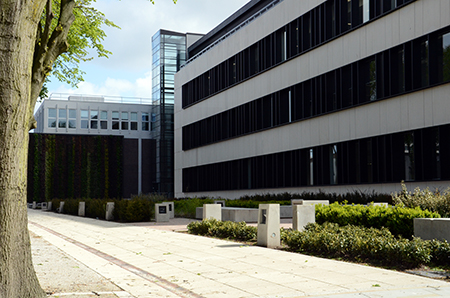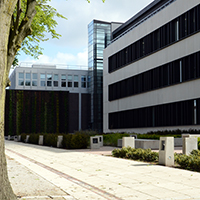 CANBERRA helped develop the Central Teaching Laboratories’ Radiation Lab
CANBERRA helped develop the Central Teaching Laboratories’ Radiation Lab
The University’s Department of Physics is working with CANBERRA, a global supplier of instrumentation for the nuclear industry, to make their products more sensitive and able to pick up lower levels of potentially harmful radiation.
Dr James Cocks is CANBERRA’s Vice-President for Research and Development, based in Connecticut, USA. He has a PhD in Nuclear Physics from the University of Liverpool.
What has your experience been like since you left the University of Liverpool?
I completed my PhD at Liverpool in 1996. It was an incredible learning experience which began with driving to CERN, Geneva with a van full of equipment – most of it manufactured by CANBERRA, incidentally! – to set up an experiment at the ISOLDE Radioactive Ion Beam Facility. During my studies I also participated in experimental collaborations in France, Poland, the US and Finland. It was a great learning experience, both academically and personally.
Three months of my PhD studies were spent in Finland at the Accelerator Laboratory, University of Jyvaskyla, and I spent the three years that followed my graduation working there as a postdoctoral researcher. This allowed me to lead and participate in collaborations with the best nuclear physics groups across the world – many of which are our customers at CANBERRA, for which we remain very grateful.
From there I moved to a company that produces 3D software emulations for training military personnel on the maintenance of military aircraft, such as the Apache helicopter. Following this, I wanted to return to nuclear physics, so I took a position at the Sellafield nuclear facility for five years.
I started working for CANBERRA in 2005 as a senior physicist, but gradually took more of an interest in the commercial side and in working with customers to develop technical solutions. It was in my role as business development manager that I reconnected with the University of Liverpool group. In 2010 we began working with the University on its Radiation Laboratory in the Central Teaching Laboratories. This really was the beginning of a close working relationship between CANBERRA and the University, a relationship that is highly valued at CANBERRA.
In 2010 I moved to the US to take the position as product director for the Radiochemistry and Detectors product line and last year I was asked to become Vice-President of Research and Development. In 2011 a contingent from the CANBERRA management team were privileged to attend the official opening of the Central Teaching Laboratories and we were able to take a good look around this impressive facility.
My PhD from Liverpool has enabled me to have a great career and now my company is benefiting from working with the University as well. It’s incredibly useful for businesses and for universities to work in partnership in this way, where each partner can bring complementary expertise, experience and resources to the table.
Why did you choose to work with the University of Liverpool?
My links with the University go back a long way, as I completed my PhD in the Nuclear Physics Group, but what most attracted us to form a long-term partnership with Liverpool was the expertise and the facilities here.
The idea is that we’re not just a supplier of equipment but a strategic partner, and this partnership has many levels. We are grateful to provide standard detectors, electronics and software for the University’s teaching program. But, in addition, we provide special custom detectors for nuclear physics research in Europe, and the group at Liverpool has a leading role in this.
We also take undergraduate and postgraduate students on summer placement at our site near Oxford – I was delighted when we recently hired a graduate to join our team there. And now we have a close research and development collaboration which promises long-term benefits to both partners.
What is the new product design project about?
In safety and security applications, radiation detection systems must be easy to use, very reliable, and very cost efficient. A key concern, particularly in environmental monitoring, is detection sensitivity. This needs to be maximised in order to minimise the duration of the sample counting and, in turn, maximise throughput and the productivity of the laboratory.
This is commercially important for CANBERRA’s customers, and is also a concern where the radioactive sample measurements are of a time-critical nature (such as in security applications).
Many of CANBERRA’s customers require such challenging measurements, and a system with improved sensitivity that uses standard CANBERRA equipment would have an immediate positive impact. An example application is the measurement programme conducted by participating laboratories around the world in the Counter Test Ban Treaty Organisation.
These laboratories are looking for the presence of banned substances at extremely low levels and are therefore forced to count samples for several days to achieve the required detection limit.
The research with the University will provide solutions that deliver significant improvements in counting time and throughput for these laboratories.
Find out more about business collaboration with the University of Liverpool here or for more on studying physics at the University, visit our study pages.
